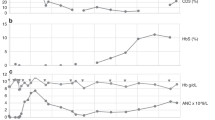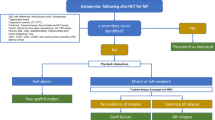Abstract
We analyzed autopsies performed in a Canadian blood and marrow transplantation (BMT) program. We aimed to assess variables that predict the performance of an autopsy, whether rates of autopsy are changing, and the rate of discordance between clinical and autopsy diagnoses. All deceased adult patients from January 1990 to December 2004 were reviewed. Autopsy rates were compared to a large teaching hospital. Of 476 myeloablative BMT patients, 225 died and 48 (27%) underwent autopsy. Autopsy was more likely in patients dying: <100 days post-BMT, in the intensive care unit, after allografting, and on weekends. Autopsy rates among BMT patients declined during the three time periods (1990–1994, 1995–1999, 2000–2004). The autopsy rate at the teaching hospital showed a similar downward temporal trend. Major and minor disagreements at autopsy were present in 16 (34%) and 14 (30%) of cases, respectively. There was no change in discordance rates over time. Thus, despite advances in diagnostic procedures, high levels of disagreement between clinical and autopsy diagnoses for BMT patients persist as autopsy rates decline. We recommend that the autopsy regains its role as a valuable investigation. This may become especially relevant in an era where patients with medical comorbidities are undergoing reduced-intensity BMT.
This is a preview of subscription content, access via your institution
Access options
Subscribe to this journal
Receive 12 print issues and online access
$259.00 per year
only $21.58 per issue
Buy this article
- Purchase on Springer Link
- Instant access to full article PDF
Prices may be subject to local taxes which are calculated during checkout

Similar content being viewed by others
References
Lowry F . Failure to perform autopsies means some MDs ‘walking in a fog of misplaced optimism’. CMAJ 1995; 153: 811–814.
Sinard JH . Factors affecting autopsy rates, autopsy request rates, and autopsy findings at a large academic medical center. Exp Mol Pathol 2001; 70: 333–343.
Allan DS, Belanger R, Busque L, Cohen S, Fish D, Roy DC et al. Maintaining high autopsy rates in a Canadian blood and marrow transplant program: preserving a diagnostic and research tool. Bone Marrow Transplant 2005; 35: 781–785.
Shojania KG, Burton EC, McDonald KM, Goldman L . Changes in rates of autopsy-detected diagnostic errors over time: a systematic review. JAMA 2003; 289: 2849–2856.
Spiliopoulou C, Papadodima S, Kotakidis N, Koutselinis A . Clinical diagnoses and autopsy findings: a retrospective analysis of 252 cases in Greece. Arch Pathol Lab Med 2005; 129: 210–214.
Avgerinos DV, Bjornsson J . Malignant neoplasms: discordance between clinical diagnoses and autopsy findings in 3,118 cases. APMIS 2001; 109: 774–780.
Burton EC, Troxclair DA, Newman III WP . Autopsy diagnoses of malignant neoplasms: how often are clinical diagnoses incorrect? JAMA 1998; 280: 1245–1248.
Xavier AC, Siqueira SA, Costa LJ, Mauad T, Nascimento Saldiva PH . Missed diagnosis in hematological patients—an autopsy study. Virchows Arch 2005; 446: 225–231.
Nichols L, Aronica P, Babe C . Are autopsies obsolete? Am J Clin Pathol 1998; 110: 210–218.
Burton JL, Wells M . The alder hey affair. Arch Dis Child 2002; 86: 4–7.
Veress B, Alafuzoff I . A retrospective analysis of clinical diagnoses and autopsy findings in 3042 cases during two different time periods. Hum Pathol 1994; 25: 140–145.
Hofmeister CC, Marinier DE, Czerlanis C, Stiff PJ . Clinical utility of autopsy after hematopoietic stem cell transplantation. Biol Blood Marrow Transplant 2007; 13: 26–30.
Sonderegger-Iseli K, Burger S, Muntwyler J, Salomon F . Diagnostic errors in three medical eras: a necropsy study. Lancet 2000; 355: 2027–2031.
Scottolini AG, Weinstein SR . The autopsy in clinical quality control. JAMA 1983; 250: 1192–1194.
Britton M . Clinical diagnostics: experience from 383 autopsied cases. Acta Med Scand 1974; 196: 211–219.
Aalten CM, Samson MM, Jansen PA . Diagnostic errors; the need to have autopsies. Neth J Med 2006; 64: 186–190.
Combes A, Mokhtari M, Couvelard A, Trouillet JL, Baudot J, Henin D et al. Clinical and autopsy diagnoses in the intensive care unit: a prospective study. Arch Intern Med 2004; 164: 389–392.
Ferguson RP, Burkhardt L, Hennawi G, Puthumana L . Consecutive autopsies on an internal medicine service. South Med J 2004; 97: 335–337.
Goldman L, Sayson R, Robbins S, Cohn LH, Bettmann M, Weisberg M . The value of the autopsy in three medical eras. N Engl J Med 1983; 308: 1000–1005.
Peacock SJ, Machin D, Duboulay CE, Kirkham N . The autopsy: a useful tool or an old relic? J Pathol 1988; 156: 9–14.
The Royal College of Pathologists of Australasia Autopsy Working Party. The decline of the hospital autopsy: a safety and quality issue for healthcare in Australia. Med J Aust 2004; 180: 281–285.
Dimopoulos G, Piagnerelli M, Berre J, Salmon I, Vincent JL . Post mortem examination in the intensive care unit: still useful? Intensive Care Med 2004; 30: 2080–2085.
Juric G, Tentor D, Jakic-Razumovic J . Autopsy findings and clinical diagnoses: retrospective study of 3,117 autopsies. Croat Med J 1999; 40: 71–76.
Baddley JW, Stroud TP, Salzman D, Pappas PG . Invasive mold infections in allogeneic bone marrow transplant recipients. Clin Infect Dis 2001; 32: 1319–1324.
Grow WB, Moreb JS, Roque D, Manion K, Leather H, Reddy V et al. Late onset of invasive Aspergillus infection in bone marrow transplant patients at a university hospital. Bone Marrow Transplant 2002; 29: 15–19.
Ninin E, Milpied N, Moreau P, Andre-Richet B, Morineau N, Mahe B et al. Longitudinal study of bacterial, viral, and fungal infections in adult recipients of bone marrow transplants. Clin Infect Dis 2001; 33: 41–47.
Osarogiagbon RU, Defor TE, Weisdorf MA, Erice A, Weisdorf DJ . CMV antigenemia following bone marrow transplantation: risk factors and outcomes. Biol Blood Marrow Transplant 2000; 6: 280–288.
Yoo JH, Lee DG, Choi SM, Choi JH, Park YH, Kim YJ et al. Infectious complications and outcomes after allogeneic hematopoietic stem cell transplantation in Korea. Bone Marrow Transplant 2004; 34: 497–504.
Maertens J, Verhaegen J, Demuynck H, Brock P, Verhoef G, Vandenberghe P et al. Autopsy-controlled prospective evaluation of serial screening for circulating galactomannan by a sandwich enzyme-linked immunosorbent assay for hematological patients at risk for invasive Aspergillosis. J Clin Microbiol 1999; 37: 3223–3228.
Herbrecht R, Letscher-Bru V, Oprea C, Lioure B, Waller J, Campos F et al. Aspergillus galactomannan detection in the diagnosis of invasive aspergillosis in cancer patients. J Clin Oncol 2002; 20: 1898–1906.
Maertens J, Verhaegen J, Lagrou K, Van EJ, Boogaerts M . Screening for circulating galactomannan as a noninvasive diagnostic tool for invasive aspergillosis in prolonged neutropenic patients and stem cell transplantation recipients: a prospective validation. Blood 2001; 97: 1604–1610.
Boeckh M, Gooley TA, Myerson D, Cunningham T, Schoch G, Bowden RA . Cytomegalovirus pp65 antigenemia-guided early treatment with ganciclovir versus ganciclovir at engraftment after allogeneic marrow transplantation: a randomized double-blind study. Blood 1996; 88: 4063–4071.
Author information
Authors and Affiliations
Corresponding author
Rights and permissions
About this article
Cite this article
Seftel, M., Ho, M., Pruthi, D. et al. High rate of discordance between clinical and autopsy diagnoses in blood and marrow transplantation. Bone Marrow Transplant 40, 1049–1053 (2007). https://doi.org/10.1038/sj.bmt.1705855
Received:
Revised:
Accepted:
Published:
Issue Date:
DOI: https://doi.org/10.1038/sj.bmt.1705855
Keywords
This article is cited by
-
Epidemiology of Invasive Candidiasis in Patients with Hematologic Malignancy on Antifungal Prophylaxis
Mycopathologia (2023)
-
Autopsy among recipients of stem cell transplant for hematologic malignancies in the modern era
Bone Marrow Transplantation (2021)
-
Being certain even when you’re wrong: heuristics and thin slicing in haematopoietic cell transplantation
Bone Marrow Transplantation (2021)
-
Comparison of clinical diagnoses and autopsy findings in 54 cases with lymphoid neoplasms
Journal of Hematopathology (2019)



